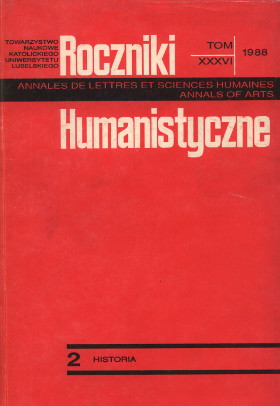Przenikanie przedstawicieli warstw niższych do stanu szlacheckiego w początkach XVII w. Na podstawie Liber Chamorum Waleriana Nekandy Trepki
Abstrakt
Commoners made their way into the privileged estates by various methods, both legal and illegal. The process created a major social problem in the 17th century, and its dimensions cannot be determined with certainty because of lack of sources. A good example is furnished by Liber Chamorum, whose author W. N. Trepka listed 2537 people who in his opinion had joined the noble estate by illegitimate means. They were burghers, peasants and people of unclear social status who usurped the noble title. Trepka’s book lists 1062 peasants, who thus account for 41.8 per cent of the total of 2537. Of the 1062, 131 (12.3 per cent of this group) are described as either pursuing crafts or being serfs of varied social and economic status; the rest (931, i.e. 87.7 per cent) are peasants with no further qualification. The group of newly ennobled burghers comprises 953 people, i.e. 37.6 per cent of all those listed in Liber Chamorum. Among them are 741 patricians (77.8 per cent) and only 212 craftsmen (22.2 per cent). The source also lists a group of 522 people of indefinite social status. Three tables in the article show the geographical origins of the new nobles; they reveal a correlation between people’s residence before and after joining the noble estate. For instance, of the 368 peasants coming from the Cracow voivodship, 306 remained there after their ennoblement. Similarly, of the 359 burghers from the same area, 280 stayed there after acquiring noble status. Most of the new nobles came from among rich peasants and burghers. They were heads of villages (42), yeomen (40), smiths (27) and millers (27). Peasants most often gained their promotion by serving a nobleman; this happened in 446 cases (42 per cent). A common way for peasants was through service as magistrates, sometimes with the support of magnates (110 cases, 10.4 per cent). No less popular, in the case of peasants, were: service to a clergyman, army service, marriage to a noblewoman, ownership or tenancy of land. Rich burghers joined the ranks of nobility in ways that Trepka does not describe. Their number is 287 (30.1 per cent). It can be supposed that the patricians would make nobles of themselves by entering the words „civis et famatus” next to their names in the city registers. Some frequent ways of social advancement for burghers, just as for peasants, were: service to a magnate (234 people, 24.5 per cent), education (87 people, 9.1 per cent), ownership of land (161 people, 16.9 per cent) and marriage to a noblewoman (29 people, 3 per cent). As the tables show, the new nobles generally did not change their place of residence and often retained their previous professional status.
Copyright (c) 1988 Roczniki Humanistyczne

Utwór dostępny jest na licencji Creative Commons Uznanie autorstwa – Użycie niekomercyjne – Bez utworów zależnych 4.0 Międzynarodowe.





